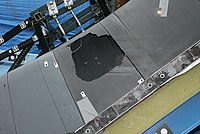
Photo from wikipedia
The impact load, such as seismic and shock wave, sometimes causes severe damage to the reinforced concrete structures. This study utilized different lengths of chopped carbon fibers to develop a… Click to show full abstract
The impact load, such as seismic and shock wave, sometimes causes severe damage to the reinforced concrete structures. This study utilized different lengths of chopped carbon fibers to develop a carbon-fiber-reinforced mortar (CFRM) and carbon-fiber-reinforced concrete (CFRC) with high impact and anti-shockwave resistance. The different lengths (6, 12, and 24 mm) of chopped carbon fibers were pneumatically dispersed and uniformly mixed into the cement with a 1% weight proportion. Then the CFRM and CFRC specimens were made for static and dynamic tests. The compressive and flexural strengths of the specimens were determined by using the standard ASTM C39/C 39M and ASTM C 293-02, respectively. Meanwhile, a free-fall impact test was done according to ACI 544.2R-89, which was used to test the impact resistances of the specimens under different impact energies. The CFRM and CFRC with a length of 6 mm exhibit maximum compressive strength. Both flexural and free-fall impact test results show that the 24 mm CFRM and CFRC enhances their maximum flexural strength and impact numbers more than the other lengths of CFRM, CFRC, and the benchmark specimens. After impact tests, the failure specimens were observed in a high-resolution optical microscope, to identify whether the failure mode is slippage or rupture of the carbon fiber. Finally, a blast wave explosion test was conducted to verify that the blast wave resistance of the 24 mm CFRC specimen was better than the 12 mm CFRC and benchmark specimens.
Journal Title: Materials
Year Published: 2021
Link to full text (if available)
Share on Social Media: Sign Up to like & get
recommendations!